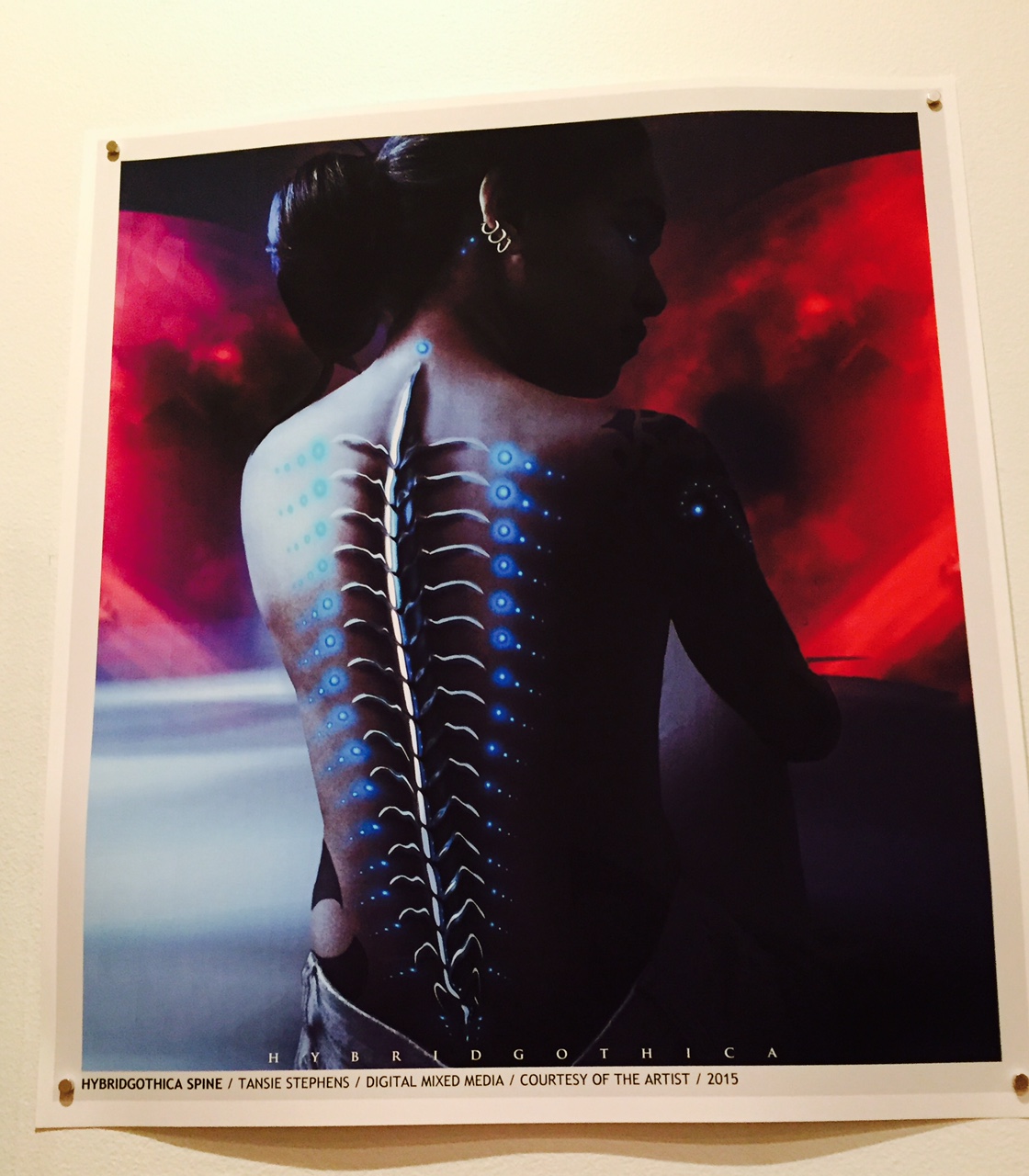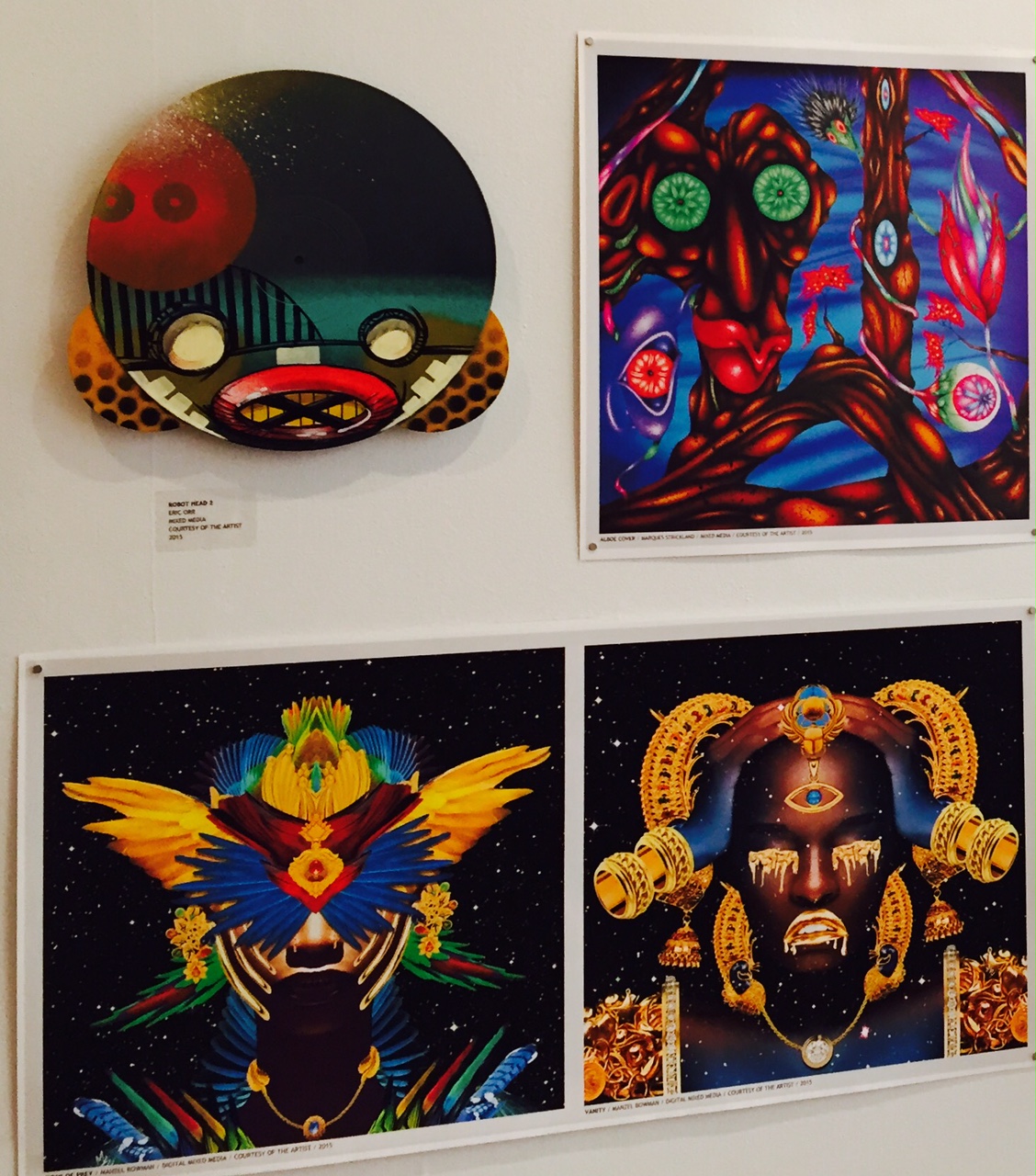Black ‘Yonder’ by Melanie Maria Goodreaux
Black ‘Yonder’ by Melanie Maria GoodreauxA Review of “Unveiling Visions: The Alchemy of the Black Imagination” Curated by John Jennings and Reynaldo Anderson The Schomburg Center for Research in Black Culture. Open until January 16, 2016.Latimer/Edison Gallery
You won’t see photos of lynchings or black figures painted in oil ironing the master’s clothes. You won’t see the cotton fields of the past unless they are reimagined for the future with a spaceship flying by. Just around the corner from the cremated remains of Langston Hughes that live eternally beneath our feet at the Schomburg Center in Harlem, is a room filled with black robots, alien lives “that matter,” and a galaxy of futuristic and “fantastic” black people whose “commitment to storytelling” is fodder for the future-minded.
The curators, John Jennings and Reynaldo Anderson, note in their commentary on the exhibition that they were inspired by John Akomfrah’s “Data Thief,” a work that features a time-traveling archaeologist who is “charged with presenting black creative history.” At the heart of their curatorial perception is the idea that the visions being “unveiled” here come from artists that are canonically connected and committed to preserving and presenting what Jennings says is, “the bold idea that we exist in a collective future.” Did you hear that? Black people boldly survive and thrive in these depictions-- in times and places beyond the here and now and the way back when. In fact, “Unveiling Visions” also contends that the intellectual orbit of its art is “part of an ever-evolving discourse between the past, present, and future.”
“Lt. Uhura,” a featured piece digitally created by Mschindo Kuumba, mothers over the Latimer/Edison gallery and is a perfect explication of black-past meets black-future in the exhibition. She is queen of the fuschia-painted wall that welcomes us into the exhibition, depicted in her historical Star-Trek attire, fit for fictional outer-space travel into the great beyond. She is one of many fantasized black queens featured in the show. Black beauty in “Unveiling Visions” blends brown familiarity with the shockingly-white electric eyes of “Lupita as Storm,” by Maya Smith and the digital-star-lit spine of Tansie Stephens’ “Hybridgothica Spine.” One can move through the exhibition and find the broad poles of the gallery brazenly bearing black beauties that hold both the archaic past of black people and the far-reaching future in one lightning-lit glance of their laser-beamed eyes. In “Unveiling Visions” black people are an artistic blend of roots, bones, connecting wires, desert-sand, techno-warriors, and books written by black people about the future preserved beneath glass.
The show also becomes present-day Harlem school kids swiping away at the provided iPad screens with their quick and curious fingers--watching image after image of themselves swoop by like rocket ships with reconfigured origins, pop-culture icons, and pyramids blasting off from futuristic landscapes on new planets where black people rule as pioneers. Our minds are mazes, opened and taken apart here, as John Jude Palencar’s “Mind of My Mind” would suggest. Like the “alchemy” of the show’s title, Palencar’s emerging “third eye” suspends itself beyond the self-reflective woman portrayed in his piece, and he, like the other artists in the show, prolongs the life-expectancy of black people and expands our own ability to envision how far-reaching our lives can be.
The artists collected here, which Jennings says he either, “admired, knew, or was told about,” express an “afrofuturist aesthetic while denoting a black speculative cultural narrative.” The art in the show fastens together Kanye West, Toni Morrison, Erykah Badu, Stevie Wonder, aliens, and ancient African spirits by the mere fact that they are all diverse black visionaries or are a part of fantasized visions of what ‘can be.’
Added to this mind-blowing idea, is Jennings’ own expansive definition of “technology,” also inspired by Akomfrah’s “Data Thief.” According to Jennings, technology does not just refer to objects but can include “the systems, processes and applied knowledge and designs used for the ‘tasks’ of humankind.” Jennings’ definition of “technology” includes race, religion, and the visual afrofuturists included in the show. He calls their art ‘pantechnological’ devices that attend to the ‘task’ of protesting and reclaiming a collective image that presents a black future.
So while Langston Hughes’ eternal presence at the library reminds us of the roots and rivers of the African American, the 87 artists featured in “Unveiling Visions” are working in tandem to “push back,” according to Jennings, against years of exclusion. “Victoria Island 2081, ” a piece included by Vigilism X Ikire Jones, presents us with the “survivalist” black man climbing the side of a building in futuristic Nigeria with just his briefcase to “move forth” towards the top. The artists here are both soothsayers and visual space-travelers. Their work is largely digital-media driven, employing a blend of new access and exploration, while defending and honoring the ancient. Eric Orr offers us “Robot-Head 1” an afro-esque tribal alien head made out of an old record, while Jennings himself has a piece in the show called “Afrofuturism,” where two heads seem intricately connected by elaborate roots and wire. And while Tim Fielder’s “Matty’s Rocket” seems to suggest that the Klan still exists in a “black future,” the story of black people is generously preserved here while creating a reimagined destiny drawn by the artist themselves.
In this way, “Unveiling Visions” expands our current ideas of what black people are and how we can exist. In “Unveiling Visions,” we live beyond earthly sidewalks bloodied by our slain young men and women. We have made it past slavery, institutionalized racism, and the presumed post-racial America.
Manzel Bowman’s “Mind Blown,” the cover image for the show, suggests a “black imagination” that combusts and projects itself forward as a fully-colorized force of gold, pink, orange, and blue. Does the colorful trajectory of this emphatic “black imagination” mystify the depths even explored by the Hubble Telescope? How far into the future can this imagination reach? Who are we there-- and how can we measure the magnificence of all that exists beyond our “yonder?”

